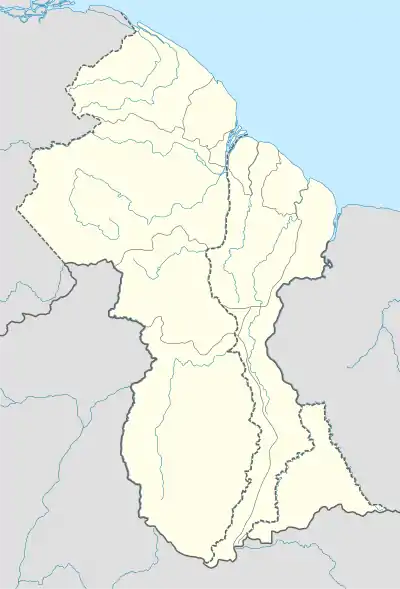Micobie | |
|---|---|
Village | |
 Micobie Location in Guyana | |
| Coordinates: 5°21′54″N 59°00′47″W / 5.3651°N 59.0131°W | |
| Country | |
| Region | Potaro-Siparuni |
| Government | |
| • Toshao | Cleveland Henry[1] |
| Area | |
| • Total | 24 sq mi (60 km2) |
| Population (2012)[2] | |
| • Total | 360 |
Micobie (also: Maicobi and Cassava Hill[2]) is a village in Potaro-Siparuni, Guyana, on the right bank of the Potaro River near Tumatumari.
History
The village was established in the 19th century. During the construction of the Denham Suspension Bridge, workers of the bridge bought their bread from the village, hence the name Cassava Hill.[2] Most villagers used to live near Tumatumari, however due to the mining operations and the destruction of the beach, the villagers moved uphill in the 1970s.[1]
In the Official Gazette of Guyana the village was misspelt Micobie which is the current name.[2] The village of El Paso is a satellite of Micobie located down the hill.[2]
Demographics
The population of the village is 360 as 2012 including El Paso.[2] The inhabitants are Amerindians[3] including members of the Macushi, Carib and Patamona tribes, who have maintained much of their culture without any racial integration.[4]
Administration
Micobie is managed by a Village Captain, a Vice Captain and six councilors.[2]
Economy
The main economic activities are subsistence farming[4] and the production of legumes for sale in neighbouring communities.[5]
Facilities
The village has two shops and a primary school.[4]
Transport
Access to the village is via the Potaro River,[4] or via the road from Linden/Mabura and Bartica/Potaro.[2]
References
- 1 2 "Micobie". Stabroek News. Retrieved 25 August 2020.
- 1 2 3 4 5 6 7 8 9 "Welcome to Micobie! — Heritage Village 2012". Guyana Chronicle. Retrieved 25 August 2020.
- ↑ "Indigenous villages". Ministry of Indigenous Peoples’ Affairs. Retrieved 25 August 2020.
- 1 2 3 4 "Environmental impact assessment report" (PDF). Ground Structures Engineering Consultants. January 2002. Archived from the original (PDF) on July 19, 2007. Retrieved 2008-06-07.
- ↑ "National report on indigenous peoples and development". United Nations Development Programme. December 1994. Archived from the original on 2008-07-20. Retrieved 2008-06-07.